How to Cook Frozen Vegetables So They Actually Taste Good!
Use and cook frozen vegetables to ensure you’re getting half your plate of veggies every day, no matter what time of year or how much time you have.
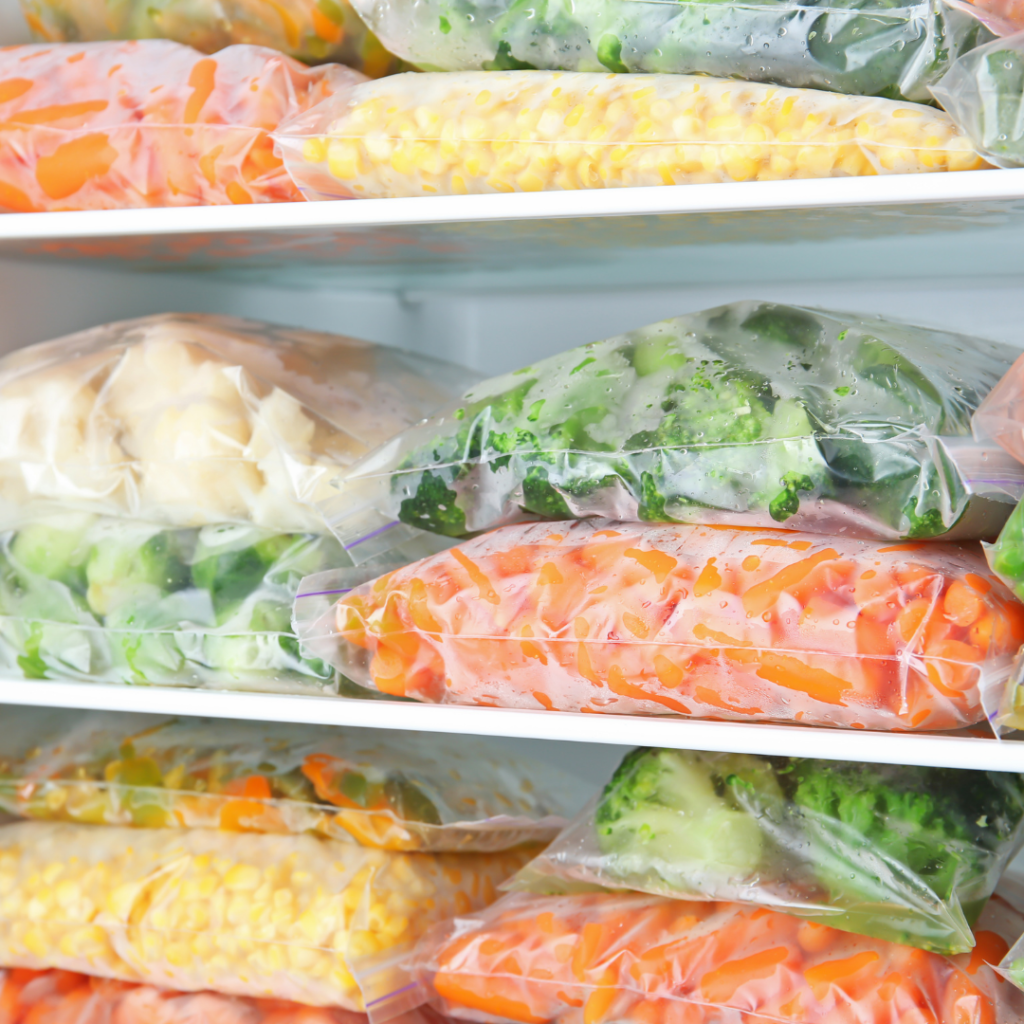
Also Read: 11 Tasty Ways to Season Vegetables, Why We Don’t Eat Enough Veggies, 7 Ways to Add More Veggies to Soup
Top Tips for Cooking Frozen Vegetables
In order to make the most of your frozen vegetables and prevent them from being soft and mushy, here are some do’s and don’ts to consider when preparing frozen vegetables.

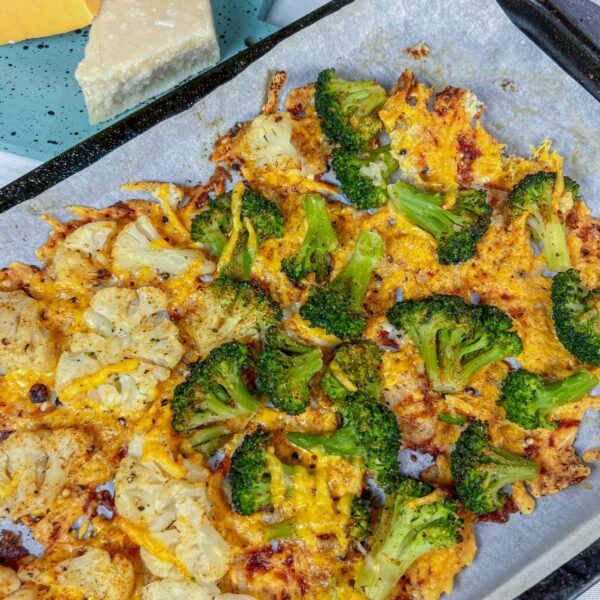
Favourite Ways to Cook Frozen Vegetables
Here are the four ways I prefer to cook frozen vegetables when I want them as a side dish. Notice boiling is not on the list because it adds too much liquid to the vegetables and can quickly lead to mushy or soggy vegetables. Try it and see!
1. Sauté Frozen Vegetables
Sauté frozen vegetables on the stove for the most control and best flavour, colour and texture.
- Pour frozen vegetables (do not thaw) into a wide pan over medium-high heat.
- Cook, uncovered, for 5-7 minutes, until heated through, stirring occasionally. Over stirring can cause them to break apart – be gentle.
- The veggies will release water, when that has evaporated, add one tablespoon of oil or butter to the pan and stir gently (avoid mushing) to get a little browning.
- Season with your favourite herbs and spices such as Italian herb seasoning, Cajun seasoning, Finishing salt, Parmesan cheese, nutritional yeast, fresh pepper and squeeze of lemon juice, a splash of soy sauce or balsamic vinegar etc. You can also add a little crushed garlic or ginger to the sauté pan for extra flavour.
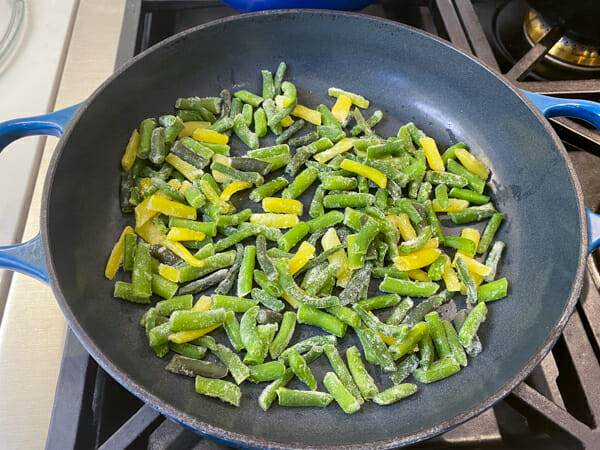
Check out: Sauteed frozen green beans, Sauteed frozen peas
2. Roast Frozen Vegetables
Roast on high heat with oil and a sprinkling of your favourite seasoning to get nicely roasted, not soggy, vegetables that will make a great side dish. Remember, do not thaw the vegetables and follow the advice carefully for heating your pan, using high heat and adding fat.
- Pre-heat your oven to 200-225°C/400-450°F.
- Coat your roasting pan with a little oil and put in the oven to preheat as well.
- Coat your frozen vegetables (do not thaw) in a bit of oil and add them in a single layer, spread apart slightly to your hot roasting pan.
- Roast for 14 to 25 minutes depending on vegetable, flipping halfway through.
14-17 minutes: asparagus, peas, corn, green beans
17-20 minutes: broccoli, Brussels sprouts, cauliflower, beets
20-25 minutes: carrots, winter squash, sweet potatoes
- Toss your roasted veggies with salt and pepper or your favourite combination of herbs and spices like rosemary, cumin, paprika, curry powder, garlic powder, onion powder, Tajin, Parmesan cheese, nutritional yeast or fresh parsley, basil or cilantro just before serving.

Check out: Oven roasted frozen cauliflower, Oven roasted frozen broccoli
3. Steam Frozen Vegetables
Steam frozen veggies on top of the stove. Steaming instead of boiling adds less water to the veggies and helps prevent them from turning mushy.
- Place steam basket in a pot and add water to bottom of basket so vegetables are not sitting in water.
- Cover and bring water to boil.
- Add frozen vegetables (do not thaw).
- Cover pot with lid and cook to desired tenderness. Check frequently, they’ll cook faster than you expect and will continue to cook a little once off the heat. The following are suggested times but will vary depending on thickness of vegetables and personal preference.
2-5 minutes: peas, corn
5-7 minutes: asparagus, broccoli, green beans, cauliflower
8-12 minutes: beets, carrots
- Add a bit of oil or butter, salt, pepper and fresh or dried herbs to season your vegetables.

4. Microwave Frozen Vegetables
Microwaving frozen vegetables is quick and easy. Use no or minimal water and check frequently to prevent over-cooking.
- Place frozen vegetables (do not thaw) in a microwaveable dish.
- Cover, but don’t seal tight, some steam should be able to escape. A piece of paper towel will work well.
- Do not add any water for small, tender vegetables like peas, corn, green beans, etc. For hardy vegetables like Brussel sprouts, winter squash, sweet potatoes or carrots add two or three tablespoons of water.
- Microwave on high for 2-6 minutes (shorter time for smaller veggies) stirring every 60 seconds after the first two minutes of cooking. Repeat until you reach your preferred texture.
- Add a bit of oil or butter, salt, pepper and fresh or dried herbs to season your vegetables.
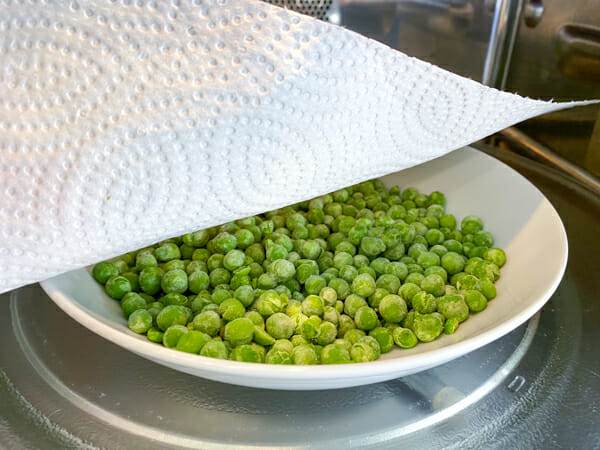
5. Use Frozen Vegetables As is in No Cook Recipes
Of course, you don’t always have to cook frozen vegetables. If using in smoothies you can add frozen vegetables like kale, spinach, peas or even cauliflower directly to the blender. For other recipes like the salads below, just thaw frozen veggies and toss into the salad bowl.
6. Add Frozen Vegetables to Other Recipes
Probably one of the best ways to use frozen vegetables is to add them to other recipes. Even if a recipe doesn’t call for them, adding a cup of frozen vegetables provides extra colour, texture and nutrients. Most soups, stews, curries or casseroles can easily accommodate more vegetables. For a little more guidance, try some of these recipes:
- Grilled Pineapple Power Bowl
- Tofu Shepherd’s Pie
- Ham and Peas Mac and Cheese
- Cauliflower Chickpea Curry (Gluten Free & Vegan)
- Pork and Green Bean Chili
- Zesty Lime & Corn and Quinoa Side Dish (Warm)
- Spinach Manicotti
- Chicken Corn Chowder
- Homemade Chicken Noodle Soup

Can You Get Crispy Frozen Vegetables?
Frozen vegetables have extra moisture which wreaks havoc on their structure, especially when thawed and cooked. That means getting crispy, crunchy frozen vegetables is almost impossible. It is not the easiest task, but it’s not impossible if you really work at it, are selective about your cooking methods and use some crunchy aids. Here’s some tips:
- Do NOT Thaw Veggies:
- Unless the recipe specifically says so, cook directly from frozen.
- If thawing, remove as much moisture as possible.
- Preheat Your Pan, Oven or Air Fryer:
- Ideally heat your sheet pan for the oven too!
- You want to hear those veggies sizzle when they hit the pan.
- Spread Vegetables Evenly:
- Spread the frozen vegetables in a single layer. Ensure they are not crowded to allow even cooking and crispiness. Overcrowding will cause them to steam and the extra moisture in them won’t evaporate quickly enough. Cook in batches if needed.
- Use Oil Sparingly:
- Lightly coat the frozen vegetables with a small amount of oil. You can use olive oil, canola oil, or a cooking spray. Too much oil can make the vegetables soggy, so use it sparingly.
- Finish with Broil (Optional):
- If your oven has a broil setting, you can briefly broil the vegetables at the end of the cooking time to add an extra layer of crispiness. Be vigilant during this step to avoid burning.
- Use Crunch Enhancing Ingredients:
- Add a crunchy topping or coating to your veggies to add a crunch factor to every bite. For example use a Toasted Seasoned Bread Crumb topping to season roasted vegetables, top cooked vegetables with nuts, coat and fry your veggies like these crispy spaghetti squash pancakes or roast veggies in a blend of cheeses spread on the baking sheet as in the recipe below.
- Serve Immediately:
- For the crispiest results, serve the frozen vegetables immediately. As they cool, they may lose some of their crispiness.
Recipe for Crispy Frozen Vegetables
Crispy Cheesey Broccoli and Cauliflower
Ingredients
- 2-3 cups broccoli and/or cauliflower pieces frozen
- 1 cup cheddar cheese shredded
- 1/2 cup Parmesan cheese grated
- 1 tsp Cajun seasoning see notes
Instructions
- Thaw frozen vegetables completely and drain well.
- Preheat oven to 425°F/218°C. Line baking sheet with parchment paper.
- Use a paper or cotton towel to pat dry the well drained frozen vegetables to remove as much moisture as possible.
- Mix cheese and spread evenly on baking sheet. Place vegetables on top in single layer, leaving a little space between each piece.
- Use the back of a cup or spatula to press and squish vegetables into the cheese. If there are any large pieces, cut them in half and place cut side down into cheese.
- Season with Cajun seasoning or a blend of paprika, oregano, black pepper and garlic powder. Or whatever type of seasoning you prefer.
- Bake for 15 to 20 minutes until cheese and vegetables start to brown and get crispy.
- Serve right away.
Video
Notes
Nutrition Facts (per serving)
How Long Do Frozen Vegetables Last
Do not hoard your frozen food! Sure, frozen food stays safe as long as it stays frozen at a consistent -18°C/0°F. But having safe, frozen food is a lot different than having tasty frozen food. Just think, frozen food with freezer burn and ice crystals is safe to eat. But it tastes horrible!
For best flavour, rotate through your frozen vegetables regularly and use within 3-6 months (preferably 3 months). Use them, don’t hoard them!

If you freeze your own garden produce and want them to last from one season to the next (10-12 months) follow all recommended freezing procedures to ensure best quality for the longest time.
Why Use Frozen Vegetables?
I love using frozen vegetables because they’re an easy and affordable way to add nutrients, color and flavor to any meal any time of year. I also love that I can try out different types of vegetables. For example when I use a frozen vegetable stir fry mix I get those little baby corns, bean sprouts and water chestnuts which I wouldn’t bother getting if I were using fresh.

There you have my favourite ways to cook frozen vegetables. Now you tell me, which method do you prefer? And, please tell me your favourite seasoning combinations – I’m always looking for new seasonings to try.
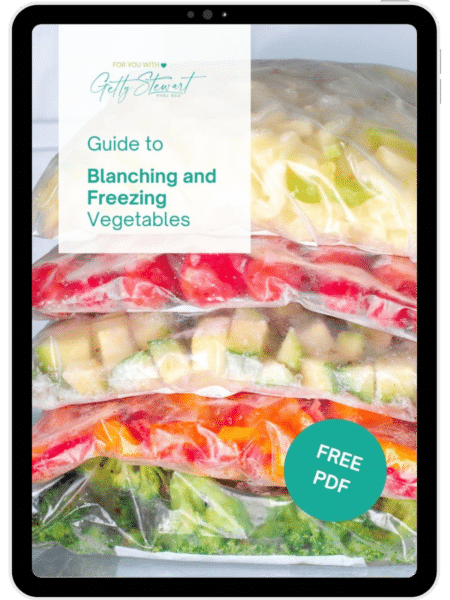
FREE Guide to Blanching & Freezing Vegetables
Blanching is easy! Use this guide as a quick reference when preserving.
This 3 page reference guide includes all the info you need to get blanching:
- A detailed, step by step how-to process.
- Blanching times for different vegetables.
- Tips to avoid freezer burn.
- Details for how to freeze fruits.
Click the link below, share your email and it’ll land in your inbox right away. Great for hanging in your cupboard or tucking into your favourite recipe book for quick, easy reference.
Cook with the seasons, effortlessly! I’m Getty, a food educator and Professional Home Economist, helping you select, store, and serve seasonal ingredients in delicious, simple, everyday meals. Sign up for seasonal tips and recipes delivered straight to your inbox, and dive deeper with my books, guides, or YouTube content.



